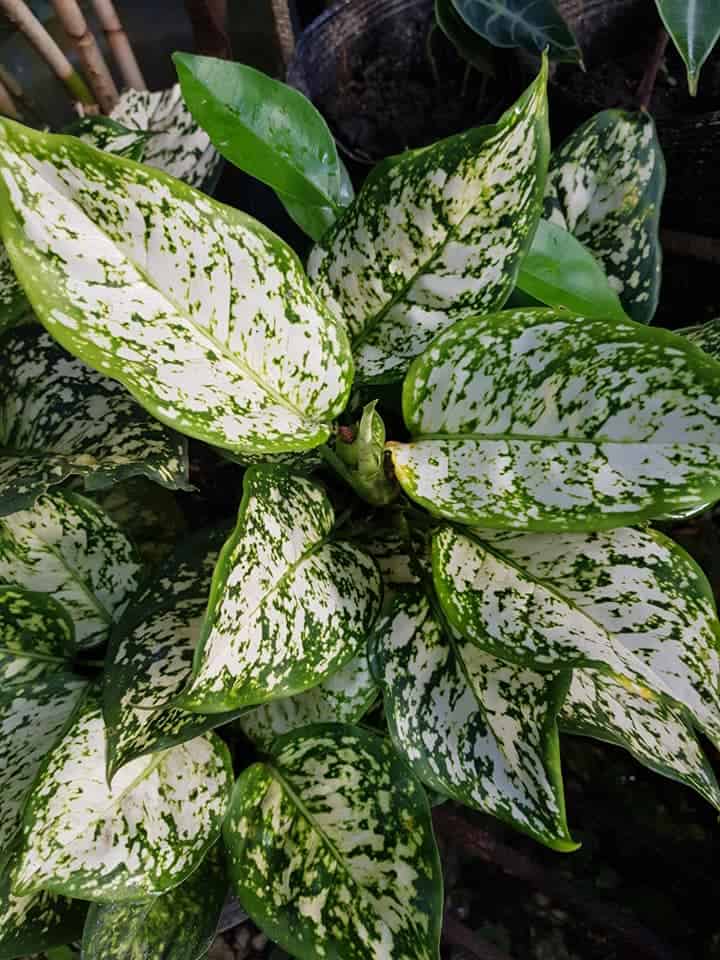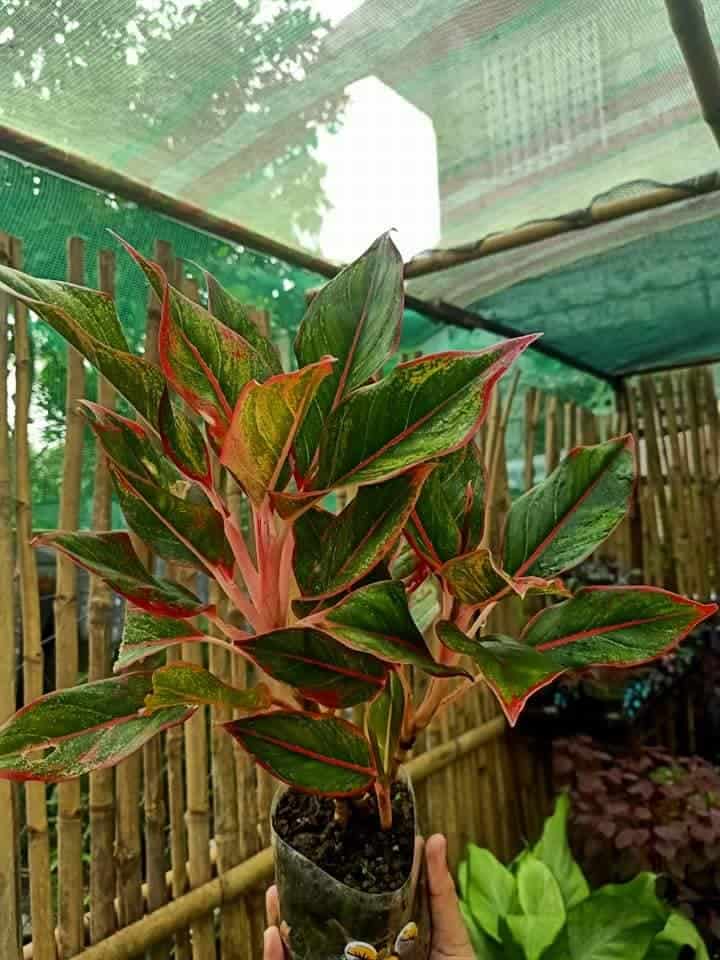Do you know Asian people grow Aglaonema plants as luck-bringing sources? With a bunch of hybrids and cultivars, Aglaonema offers wide leaf blades, making the perfect houseplants.
You can populate these plants through stem cuttings and dividing the basal shoots, but before doing this, choose your favorite Aglaonema from the list below.
Table of Contents Show
22+ Stunning Aglaonema Plant Varieties
Aglaonema, commonly known as Chinese Evergreen, has foliage ovate to dagger shape with tapering ends in various colors and patterns.
Here is a list of some common varieties of Algonema, along with its features.
1. Aglaonema Red Anjamani
The stunning houseplant is due to its bright red foilage with a few deep green borders and spots.
The Aglaonema ‘Red Anjamani’ thrives in low light, but the red in your plant leaves has to compromise with a few green patterns.
However, this Red Anjamani retains its vibrant hue throughout the year under proper care.
These plants are great for spaces shelving or with an upward-climbing trellis.
Fun Fact: Most of the Aglaonema Plant varieties with pink and red leaves grow in subtropical and tropical rainforests of Asia.
2. Aglaonema White Calcite
They are slow-growing, ornamental houseplants with decent white variegation on the foliage.
Besides, the plant is easy and simple to grow in organically rich and moist soil.

Many mistakes this dual-tone Algonema for a caladium, but the White Calcite has distinct egg-shaped foliage.
Like other indoor succulents, Aglaonema White Calcite will need extra love and care to keep the gorgeous plant healthy and well-developed.
3. Aglaonema Tigress
Aglaonema Tigress can grow as high as 1 to 2 feet and is one of the easiest succulents to grow.
As the name suggests, they have an interesting dark stripe on the leaves, making a great office plant.
Also, if you have very little natural light in your room, Tigress is for you.
Moreover, the plant doesn’t mind growing under artificial light conditions.
4. Aglaonema Pictum Tricolour
The pictum tricolor stands out among the Aglaonema varieties due to its unusual color combinations.
Aglaonema pictum tricolor boasts oval-shaped leaves and an upright growth habit of about 2 feet.
Originating from subtropical and tropical regions of Asia, this plant can live up to eight years under proper care.
Furthermore, the plant must be in indirect sunlight near the windows or balcony.
Pictum Tricolor plant is one of the rare varieties of aglaonema with the price as high as $200.
5. Aglaonema Chocolate
The chocolate-colored leaves of the plant are 4-6 inches long and 2-4 inches wide.
Moreover, the chocolate look-alike plant can reach a 0.5-1 m height.
Unfortunately, this variety of plants is unavailable worldwide, adding it to the list of expensive Aglaonema.
You might have to scroll down some online sites for the plant.
6. Aglaonema Silver Bay
This variety of Aglaonema outstands others with its fast-growing habit.
The unique color combination of light green, dark green, and silver makes its beautiful variegated leaves.
However, the plant is very delicate to cold temperatures and will stop growing if the temperature drops below 50°F.
Besides, the plant is also useful in making permanent press fabrics that hold their shape and are wrinkle-resistant.
7. Aglaonema Prestige
Aglaonema Prestige produces flowers, green and white-colored, during summer.
The’ Prestige’ variety of aglaonema plants is well adapted to grow even in low light conditions.
However, cold drafts and frost lead to injuries. So, place them in a warmer spot.
The plant can also be used as decor to boost color and decorate your working space.
8. Aglaonema Creta
On top of delicate pale pink stems, the leaves are a luscious green with burgundy crimson splashes and borders.
The plant can grow up to 4 feet tall and rarely blooms during its growing season.

Moreover, the plant also features bright pink and pale cream spots coming down from the center and framing the border of each foliage.
9. Aglaonema Silver Queen
The plant’s amazing and classy leaves, with a blend of silver and green, fit the name Queen.
It can grow up to 55-65 centimeters tall during favorable conditions.
Queen loses its lower leaves and develops a trunk-like stem as it matures.
10. Aglaonema Red Valentine
The Red Valentine has enticing leaves with rose-pink tones and dark green spots petiole, midrib, and margin are all dark green.
Interestingly, this Aglaonema retains two different colored leaves throughout its lifetime.
However, the young Valentine has pink leaves, turning red on maturity.
Meanwhile, the plant can grow in less humid conditions but needs bright indirect sunlight to maintain its charm.
If the conditions are favorable, the plant can live for many years adding beauty to your place.
11. Aglaonema Pink Valentine
Pink Valentine is another Aglaonema pink variety, commonly called ‘Pink Dalmatian.’
Like Red Valentine, the plant has shiny and leathery leaves with beautiful-looking shades of green and a splattering of pink spots.
Further, the perfectly aligned pink and green color on the oval-shaped leaves of Pink Valentine is truly fascinating to our eyes.
They bloom white-colored flowers over time, uncommon as indoor houseplants.
12. Aglaonema Diamond Bay
Aglaonema diamond bay might not be unknown to someone who has visited Thailand and Indonesia.
The heavily variegated white and colorful green foliage grows at the top of short stems, growing as high as 6-8 inches.
However, despite its gorgeous looks, the plant is not in demand compared to other varieties of colorful-looking Aglaonema plants.
Generally, you don’t have to water the plant as often as other indoor succulents, and the plant can tolerate medium and low lighting conditions.
13. Aglaonema Siam Aurora
The beautiful Siam Aurora is one of the common Red varieties of the Aglaonema plant.
Siam Aurora is a showstopper in any houseplant collection thanks to its exotic red-and-gold leaf variegation.

It’s also one of the most tolerant, surviving several weeks of neglect.
And the plant also grows outdoors in USDA zones 10 and 11, which have more favorable temperature conditions for the plant to grow and develop.
14. Aglaonema Cutlass
Chinese Evergreen Cutlass has been used as an interior design plant since the early 1970s for its tolerance to low light conditions.
The plant has long, fleshy green stems with glossy dark green and sliver-colored leaves.
Besides, the foliage grows and clusters on the short stem, giving the plant a busy appearance.
When inside an ideal room temperature (70-80°F), the Aglaonema Cutlass plant can reach up to 75 cm.
Aglaonemas are freeze babies, so keep them away from frost and cold drafts.
15. Aglaonema Maria
A perennial plant, Maria is happiest when placed under bright yet filtered sunlight.
While low light and humidity don’t bother your plant, the color fades away by harsh sunlight, leaving the leaves yellowing and further scorching.
The plant is also straightforward to take care of because of its slow-growing nature.
10 Additional Varieties of Aglaonema
| Algaonema Varieties | Description |
|---|---|
| Aglaonema Siam Aurora | Large upright leaves marked with red splashes to the margin. |
| Aglaonema Snow White | The varigated leaves have pale-white color with scattered green freckels and green on the margin. |
| Aglaonema White Rain | The leaves are oblong and narrow that have white or cream midveins and green along the margins. |
| Aglaonema Bidadari | Large ovate leaves with glossy pinkish-cream hue. |
| Aglaonema Modestum | Stem has silver-grey blotches and jade coloured waxy leaves. |
| Aglaonema Diamond Bay | Mutant variety of Aglonema with shimmery sliver tone foliage. |
| Aglaonema Green Papaya | Intense green leaves with pink streak running through the centre of the leaves. |
| Aglaonema Pink Moon | It features oval-shaped dark green leaves, separated by pink lines along the center and moon-like specs throughout. |
| Aglaonema Super White | Leaves are silvery-white, elliptic to lance shaped with green margin. |
FAQs About Aglaonema Varieties
How often does Aglaonema flower?
As a houseplant, Aglaonema rarely blooms in the late summer or early fall. Flowering could also occur in response to stress.
However, gardeners prefer removing the flowers to direct their energy toward growing the foliage.
Does Aglaonema need sunlight?
Aglaonema’s colorful and variegated variety requires medium to bright, indirect sunlight to perpetuate its luster, while the green varieties can still do well in low-light conditions.
Keep in mind to never place these plants under direct scorching sunlight.
Does Aglaonema multiply?
The most common method to propagate or multiply Aglaonema is via stem cutting and root cutting.
From Editorial Team
Conclusion!
Whether you want a miniature plant or colorful foliage, Aglaonema is one of the perfect choices on the market.
But, you must be careful not to overwater or underwater them and keep them from harmful pests and insects.
